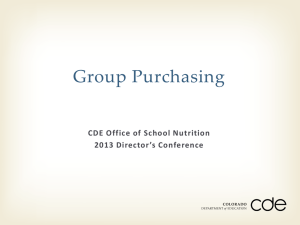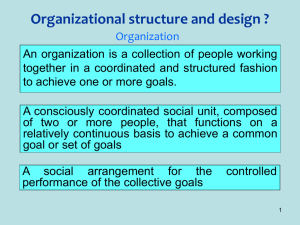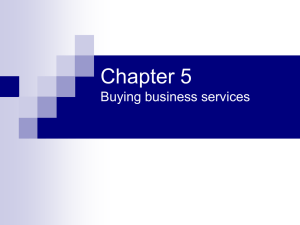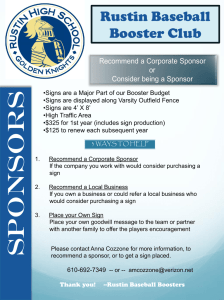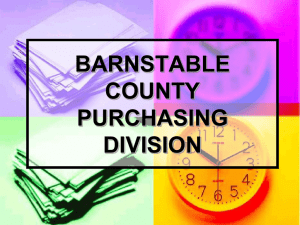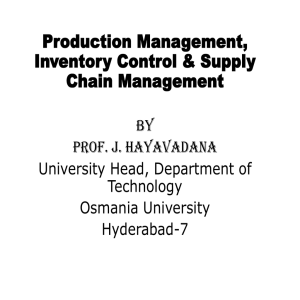Nowadays, e-procurement encompasses a variety of forms. In order
advertisement
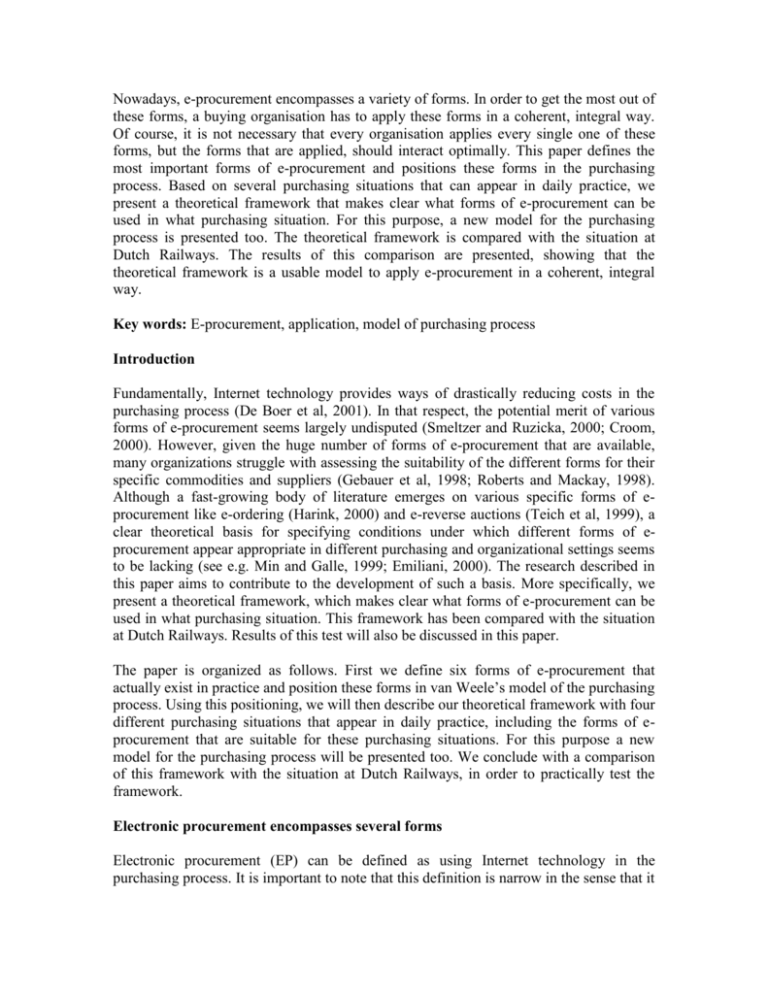
Nowadays, e-procurement encompasses a variety of forms. In order to get the most out of these forms, a buying organisation has to apply these forms in a coherent, integral way. Of course, it is not necessary that every organisation applies every single one of these forms, but the forms that are applied, should interact optimally. This paper defines the most important forms of e-procurement and positions these forms in the purchasing process. Based on several purchasing situations that can appear in daily practice, we present a theoretical framework that makes clear what forms of e-procurement can be used in what purchasing situation. For this purpose, a new model for the purchasing process is presented too. The theoretical framework is compared with the situation at Dutch Railways. The results of this comparison are presented, showing that the theoretical framework is a usable model to apply e-procurement in a coherent, integral way. Key words: E-procurement, application, model of purchasing process Introduction Fundamentally, Internet technology provides ways of drastically reducing costs in the purchasing process (De Boer et al, 2001). In that respect, the potential merit of various forms of e-procurement seems largely undisputed (Smeltzer and Ruzicka, 2000; Croom, 2000). However, given the huge number of forms of e-procurement that are available, many organizations struggle with assessing the suitability of the different forms for their specific commodities and suppliers (Gebauer et al, 1998; Roberts and Mackay, 1998). Although a fast-growing body of literature emerges on various specific forms of eprocurement like e-ordering (Harink, 2000) and e-reverse auctions (Teich et al, 1999), a clear theoretical basis for specifying conditions under which different forms of eprocurement appear appropriate in different purchasing and organizational settings seems to be lacking (see e.g. Min and Galle, 1999; Emiliani, 2000). The research described in this paper aims to contribute to the development of such a basis. More specifically, we present a theoretical framework, which makes clear what forms of e-procurement can be used in what purchasing situation. This framework has been compared with the situation at Dutch Railways. Results of this test will also be discussed in this paper. The paper is organized as follows. First we define six forms of e-procurement that actually exist in practice and position these forms in van Weele’s model of the purchasing process. Using this positioning, we will then describe our theoretical framework with four different purchasing situations that appear in daily practice, including the forms of eprocurement that are suitable for these purchasing situations. For this purpose a new model for the purchasing process will be presented too. We conclude with a comparison of this framework with the situation at Dutch Railways, in order to practically test the framework. Electronic procurement encompasses several forms Electronic procurement (EP) can be defined as using Internet technology in the purchasing process. It is important to note that this definition is narrow in the sense that it excludes old applications like ordering by telephone or by fax. On the other hand, this definition is relatively wide, because it not only encompasses the use of Internet applications in the purchasing process, but it also includes the use of intranet and extranet applications1. For example, using this definition ordering office supplies by using a supplier catalog on a website is a form of EP. Based on this definition of EP a large number of forms of EP can be distinguished. Some of these forms have received a lot of attention already and they are by now quite welldefined and relatively well-developed. Other forms of EP are still quite young and immature. Some of them will mature, others may never reach that state. In this paper we focus on the forms of EP that seem quite well-defined and relatively well-developed. We distinguish between the following forms: e-ordering; web-based ERP; e-sourcing; e-tendering; e-reverse auctioning; e-informing. Definition and positioning of forms of EP In the following we shall briefly define the six forms of EP. E-ordering as well as web-based ERP is the process of creating and approving purchasing requisitions, placing purchase orders as well as receiving goods and services ordered, by using a software system based on Internet technology. In the case of e-ordering the goods and services ordered are indirect goods and services (i.e., non-product related goods and services). The supporting software system (an ordering catalog system) is usually used by all employees of an organisation. In the case of web-based ERP the goods and services ordered are product-related. These are called direct goods and services. Usually only the employees of the purchasing department (or the planning department) are using the supporting software system (a web-based ERP-system (Enterprise Resource Planning)). It maybe clear that ordering of indirect goods and services usually takes place on an ad hoc basis, whereas ordering of direct goods and services usually is plan-based. E-sourcing is the process of identifying new suppliers for a specific spend category, using Internet technology (usually the Internet itself). By identifying new suppliers a purchaser can increase the competitiveness in the tactical purchasing process for this spend category. E-sourcing is a way of decreasing the supply risk associated with this spend category (Kraljic, 1983). E-tendering is the process of sending RFI’s and RFP’s to suppliers and receiving the responses of suppliers back, using Internet technology. Usually e-tendering is supported by an e-tendering system. Often the e-tendering system also supports the analysis and 1 One of the most characteristic elements of Internet technology is the TCP/IP-protocol. The Internet as well as intranets and extranets are based on this protocol. assessment of responses. E-tendering does not include closing the deal with a supplier. As a matter of fact, e-tendering smoothens a large part of the tactical purchasing process (Van Weele, 1988), without focusing on the content (i.e. spend category) of that process. In practice an auction enables a supplier to sell (surplus) goods and services to a number of (known or unknown) buying organizations. During a relatively short time frame the buying organizations involved submit bids for the goods and services that are auctioned. The auction operates with an upward price mechanism or a downward price mechanism. A reversed auction is the opposite: it enables a buying organisation to buy goods and services needed from a number of (known of unknown) suppliers. E-reverse auctioning is the Internet technology based equivalent of reverse auction. Usually e-reverse auctioning focuses on the price of the goods and services auctioned. In most cases, other criteria are neglected during the e-reverse auction. Of course, other criteria can be used in a previous phase in order to determine which suppliers should be invited to join the e-reverse auction. E-reverse auctioning does really close a deal between a buying organization and a supplier, if parties agree on the price. Unlike the previous forms, e-informing is a form of EP that is not directly associated with a phase in the purchasing process like contracting or ordering. E-informing is the process of gathering and distributing purchasing information both from and to internal and external parties, using Internet technology. For example, publishing purchasing management information on an extranet that can be accessed by internal clients and suppliers is a way of e-informing. This form is also called purchasing intelligence or spend control. Figure 1 shows the six forms of e-procurement plotted in the purchasing process according to (van Weele, 1988)2. E-sourcing supports the specification phase: it identifies suppliers that can be used in the selection phase. E-tendering supports the selection phase: it facilitates the RFI- and RFP-activities, usually including support for the analysis and assessment activities. E-reverse auctioning supports the contract phase3: it enables closing a deal with a supplier. Additionally, we have included a separation between transaction oriented forms and information oriented forms. The transaction oriented forms are separated in indirect transactions and direct transactions. 2 The figure suggests a 1:1 relation between three forms of e-procurement and the three phases of the tactical procurement process. As can be concluded from the description of each form, forms can also support some activities in the previous or next phase. The figure relates a form to the phase, where the form optimally fits. 3 This paper assumes –for the sake of ease- that the contract phase encompasses price negotiation. Of course, usually negotiations also held about other aspects than price. It is assumed that the negotiations about these aspects are part of the selection phase. tactical procurement process operational procurement process transactions direct spend web-based ERP e-sourcing indirect spend e-reverse e-tendering auctioning e-ordering information e-informing PricewaterhouseCoopers Figure 1 Theoretical framework relates purchasing situations with forms of EP When defining and positioning the six forms of EP, we have used van Weele’s model of the purchasing process. This easy-to-remember model can be used very good to treat the purchasing process in a general way. Unfortunately, the model is not capable of capturing a number of purchasing situations that appear in daily practice. For instance, if a buying organisation contracts three suppliers for temp labour, this can be modeled by using the first three phases of the model (these three phases form the tactical purchasing process). When a temp is needed in business operations, these contracts can however not be used immediately. As a matter of fact, the buying organisation has to submit a request for this specific temp at the three contracted suppliers and see what they have to offer this time. Based on the offers received, the buying organisation has to decide where the temp will be contracted. It is clear that the buying organisation more or less has to go through the specification phase (what kind of temp do we need this time?), the selection phase (which of the three contracted suppliers do we choose this time?) and the contract phase (which person do we contract this time?) again. As opposed to the tactical purchasing process, these three phases are not executed on the level of a complete spend category (i.c. temp labour), but on the level of a specific operational need (i.c. a specific temp). Once these three phases are executed, the remaining three phases of the purchasing process of van Weele’s model have to be executed. With a small extension of van Weele’s model, it is possible to create a new model that is capable of capturing more purchasing situations (including the one mentioned above). In the new model of the purchasing process, we distinguish nine phases (instead of six phases). The first three phases form the tactical purchasing process and are exactly the same as in van Weele’s model. The remaining six phases form the operational procurement process. The first three phases (complete specification, complete selection, complete contract) form the ‘completion process’, because these three phases complete existing contracts so that they can be used operationally. Without these three phases, some contracts (like temp labour contracts) that result from the tactical purchasing process are not usable (ordering cannot be executed). The last three phases form the ‘call off process’ and coincide with the last three phases of van Weele’s model. The new model for the purchasing process is depicted in figure 2. tactical procurement process operational procurement process completion process specify select contract call off process complete complete complete specifiselection contract cation framework contract call off contract order monitor service subcontract Figure 2 Contracts that result from the tactical purchasing process can be divided in: Contracts that can be used operationally immediately (products, prices, lead times, etc . are known). These contracts are called call off contracts; Contracts that cannot be used operationally immediately (products, prices, lead times are not (all) known). These contracts are called framework contracts. Of course, the completion process is not necessary for call off contracts, but only for framework contracts. By using this new model of the purchasing process, figure 1 can be converted into figure 3. tactical procurement process operational procurement process completion process specify select contract complete complete complete specifiselection contract cation transactions direct spend information Figure 3 call off process order monitor web-based ERP e-sourcing e-tendering e-reverse auctioning e-tendering indirect spend e-reverse auctioning e-ordering e-informing service Note that e-sourcing will not be used in the complete specification phase, because there is no need to identify new suppliers in that phase. Moreover, in practice e-tendering is only rarely used in the complete selection phase, mainly because a need has to be fulfilled quickly and e-tendering might be too time-consuming. Based on the new model of the purchasing process, as shown in figure 2, four purchasing situations that can be distinguished:1. there is an operational need that can be met by using a call off contract; 2. there is an operational need that can be met by using a framework contract; 3. there is an operational need that can not be met by any contract; 4. there is a future need, that requires action. This four purchasing situations are clarified in figure 4. As can be seen in figure 4, every purchasing situation means that a number of phases of the purchasing process have to be Future need Operational need Wait No Arrange something now? No Yes No Is there an item in our catalog of products and services? Is there a contracted supplier? Yes Yes 4 1 specify 3 select complete complete complete specifi- selection contract contract cation 2 framework contract call off contract Figure 4 executed. order subcontract monitor service When combining figure 3 with figure 4, we get a relation between every purchasing situation and the forms of EP that can be used to support this purchasing situation, see figure 5. The figure makes clear that the output of e-tendering (in the tactical purchasing process) can be the input of e-reverse auctioning (in the tactical purchasing process). The figure also makes clear that e-reverse auctioning can be used in the tactical procurement process to make a deal with f.i. a number of suppliers for temp labour and can additionally be used in the operational procurement process (in the completion process) to make a deal with one supplier with respect to a specific temp that is needed operationally. Other relations can also be derived from figure 5. Future need Operational need Wait Arrange something now? No No Yes No Is there an item in our catalog of products and services? Is there a contracted supplier? Yes Yes 4 1 specify completecomplete complete specifi- selection contract select contract cation 2 3 transactions direct spend order monitor service web-based ERP e-sourcing e-tendering e-reverse auctioning e-tendering indirect spend e-reverse auctioning e-ordering information e-informing Figure 5 Comparison of theoretical framework with situation at Dutch Railways Dutch Railways (NS) is one of the first companies in the world that is currently implementing an ‘integral EP-system’ that supports all nine phases of the purchasing process of figure 5. At the end of 1999 NS has decided to buy software products from Ariba in order to realize this integral EP-system. In order to cover all nine phases of the purchasing process with the integral EP-system, NS had to buy three software products of Ariba, namely: Ariba Buyer; Ariba Contract Manager; Ariba Enterprise Sourcing. Looking at (the names of) the software products of Ariba, one of the first observations is that:- Ariba Buyer supports e-ordering; Ariba Contract Manager supports a specific part of e-informing (contract management) and (therefore also) a part of the contract phase; Ariba Enterprise Sourcing supports e-tendering and e-reverse auctioning. Note that Ariba Enterprise Sourcing does not support e-sourcing, although the name of the software product might suggest this. This mismatch of names appears also with software products of other software vendors, so it might be wise to change the name of the form e-sourcing into a name that better matches daily practice. Note also that NS has not bought a software product to support e-sourcing. E-sourcing is supported by using specific websites on the internet by the purchasers. The purchasing process is usually initiated by a user that has a need. At NS the user can search for all applicable catalog items (using a comprehensive search engine) in Ariba Buyer. If the user can satisfy his or her need with a catalog item, the user pushes a purchasing request into the workflow engine of Ariba Buyer. After approval of the purchasing request, the order is sent electronically to the supplier (through an internethub called the Ariba Supplier Network). In relation to figure 5, the catalog items in Ariba Buyer have to be seen as the items in the catalog of products and services, mentioned in figure 5. E-ordering is supported by Ariba Buyer. If the need of the user cannot be satisfied by means of a catalog item, the EP-system will automatically show a list of all Master Agreements with the items that are part of these Master Agreements. If the user can satisfy his or her need with an item of a Master Agreement, the user will push a purchase request with this item into the workflow engine of Ariba Buyer. In relation to figure 5, the items that are part of Master Agreements have to be seen as items in the catalog of products and service too. Apparently, NS has decided to make a split between two types of items: catalog items and Master Agreement items (that are not in the catalog). In figure 5 these two types of items are treated as one type of items. If the need of the user can still not be satisfied, the user enters the Master Agreements that do not contain specific items. For instance, this can be contracts with a couple of suppliers for a specific commodity, without having agreements on concrete items, prices, lead times, et cetera. In this case the completion process (complete specification, complete selection and complete contract) will be executed. Ariba Enterprise Sourcing can be used, for example to execute an e-reverse auction. In relation to figure 5, the suppliers with these Master Agreements have to be seen as the contracted suppliers, mentioned in figure 5. If there is no contract at all, the user enters a purchase request for a new item. This request will be evaluated by the purchaser. If the purchaser decides to buy this item, the tactical procurement process will be executed, possibly making use of e-tendering or ereverse auctioning, supported by Ariba Enterprise Sourcing. At the end this can lead to an extension of the catalog items (catalog items are added in Ariba Buyer, so e-ordering can take place) or to more Master Agreements (items). Conclusion This paper has presented a theoretical framework that makes clear what forms of eprocurement can be used in what purchasing situation. For this purpose, a new model for the purchasing process has been presented too. The theoretical framework is compared with the situation at Dutch Railways. This comparison shows that the theoretical framework properly models the situation at Dutch Railways. Of course, the theoretical framework has to be compared to other situations as well in order to draw solid conclusions, but it seems that the theoretical framework is a usable model to implement e-procurement in a coherent, integral way. References Boer, L. de, Harink, J.H.A., Heijboer, G.J., 2001, A conceptual model for assessing the impact of electronic procurement, proceedings of Ipsera congress, Jönnkoping, Sweden, 2001 Croom, S.R., 2000. The impact of web-based procurement on the management of operating resources supply. The Journal of Supply Chain Management, Winter 2000. Emiliani, M.L., 2000. Business-to-business online auctions: key issues for purchasing process improvement, Supply Chain Management: An International Journal 5(4), 176-186. Harink, J.H.A., 2000. Excelleren met elektronisch inkopen (Excelling with electronic purchasing). Samsom, Alphen aan den Rijn. Kraljic, P., 1983. Purchasing must become supply management. Harvard Business Review, September-October, 109-117. Min, H. and Galle, W.P., 1999. Electronic commerce usage in business-to-business purchasing. International Journal of Operations & Production Management 19(9), 909-921. Roberts, B. and Mackay, M., 1998. IT supporting supplier relationships: The role of electronic commerce. European Journal of Purchasing & Supply Management 4(3), 175-184. Smeltzer, L. and Ruzicka, M., 2000. Electronic Reverse Auctions: Integrating the Tool with the Strategic-Sourcing Process. Practix, June 2000. Teich, J., Wallenius, H. and Wallenius, J., 1999. Multiple-issue auction and market algorithms for the world wide web. Decision Support Systems, 26, 49-66. Weele, A. van, 1988, Inkoop in strategisch perspectief. Samsom, Alphen ad Rijn


